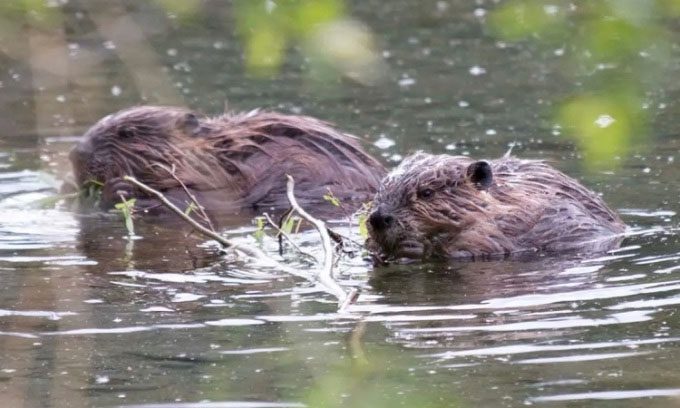Researchers have discovered that beavers are invading the Alaskan tundra, completely altering the waterways in the region and accelerating climate change in the Arctic.
Ken Tape, an ecologist at the University of Alaska, Fairbanks, stated that the changes caused by beavers in Alaska are so pronounced that they can be seen from space. As the Arctic tundra warms, trees are growing along rivers and streams, creating an ideal habitat for beavers. These animals construct their lodges by gnawing and transporting wood to build dams, blocking fast-flowing rivers and streams to create lush ponds.

A pair of beavers gnawing on a branch in shallow waters at Glennallen, Alaska. (Photo: Ken Tape)
The invasion of beavers into the tundra has mixed effects. The beaver ponds create green oases that enhance biodiversity, but they also expedite the climate crisis. Tape and his colleagues evaluated aerial photographs from the early 1950s and found no signs of beavers in the Arctic tundra of Alaska. The first indications of beavers appeared in photographs taken in 1980. In satellite images from 2000 to 2010, the number of beaver ponds doubled. Overall, the satellites revealed more than 11,000 beaver ponds across the tundra. According to Tape, beaver ponds are now densely populated in western Alaska.
Tape presented the study at the American Geophysical Union meeting last December. He used satellite imagery to search for changes in the vegetation of the tundra but was surprised to find that beaver activities had completely transformed the landscape across Alaska.
The rate of construction and the severe impact of beavers on the landscape are very similar to that of wildfires. Permafrost covers about a quarter of the Northern Hemisphere and nearly 85% of Alaska. As temperatures rise, this layer of soil thaws, releasing greenhouse gases such as carbon dioxide and methane into the atmosphere. Beaver ponds thaw the surrounding permafrost, further exacerbating the climate crisis.
According to researchers, it is certain that more beavers will spread across the tundra in the future, continuing to move northward as the Arctic warms. The strip of land in northern Alaska, north of the Brooks Range, remains devoid of beavers. However, this will not last long. A large population of beavers is residing just across the mountain range.


















































